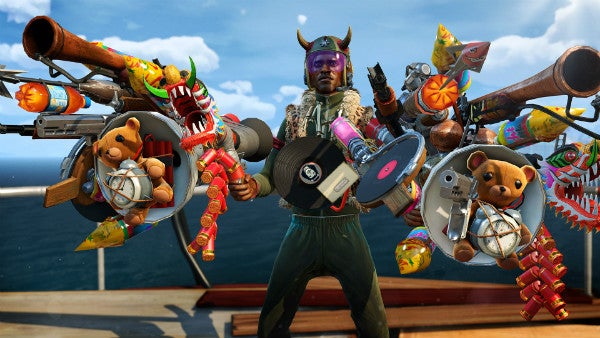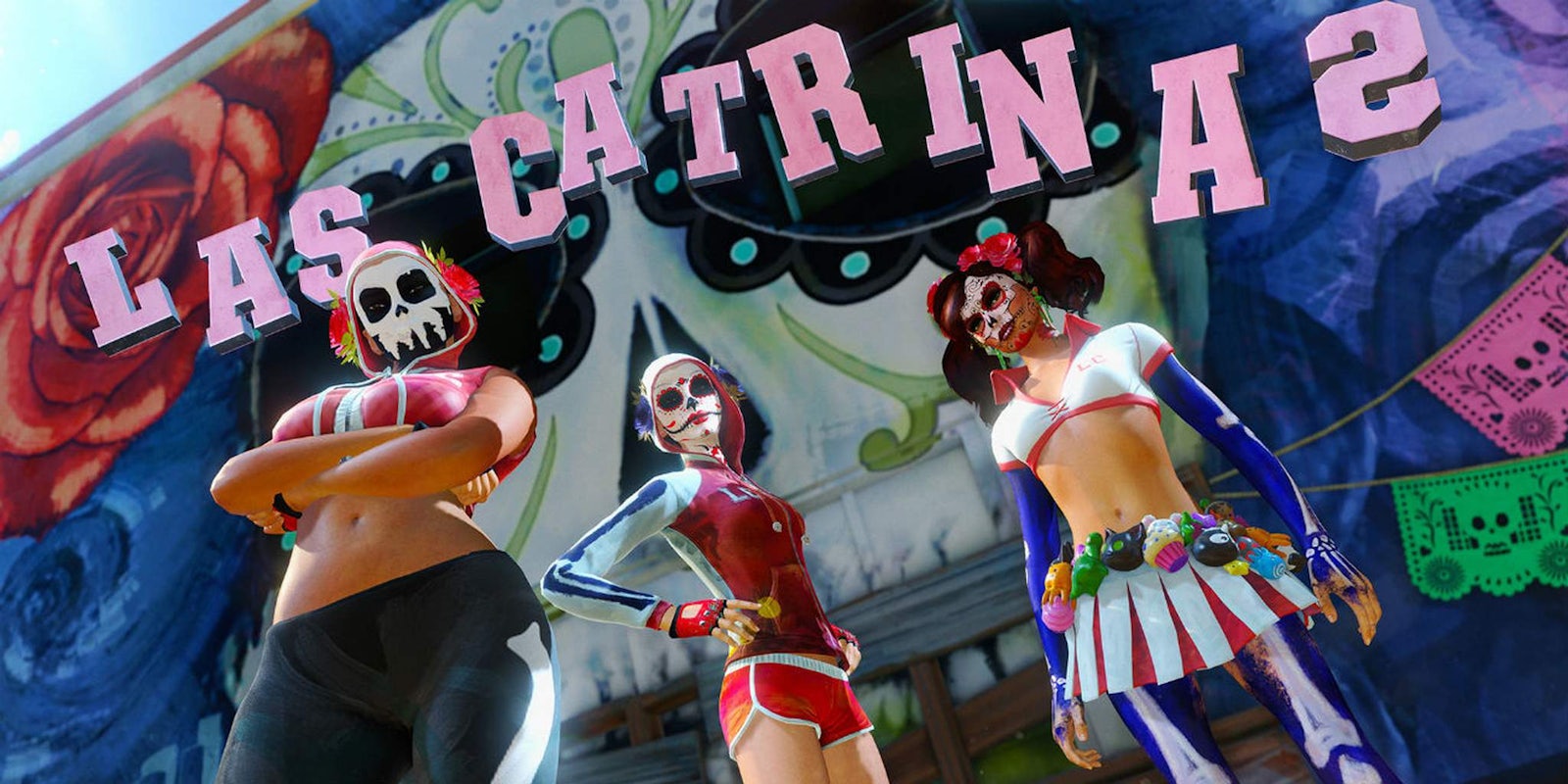Sunset Overdrive presents itself as having a punk mentality. Punk is about questioning and defying the status quo. Sunset Overdrive, on the other hand, is about as status quo as it gets.
Have you ever met someone you might enjoy spending time with if they just stopped trying so hard? They’re good natured, a little charming, and easy on the eyes. Then their desperation to be liked just gets on your nerves. If that person were a game, it would be Sunset Overdrive.
Sunset Overdrive is gorgeously drawn and animated. It presents an open world that’s fun to just run around in. It also got on my nerves so badly that I often dreaded the story elements I had to play through. I wanted to be left alone, to play in this virtual playground as I pleased. The player doesn’t have to pursue the story missions in pursuit of the game’s ending, to be fair. There are side quests and challenges to tackle aplenty, and a ton of objects to collect.
But Sunset Overdrive is also like the kid in school who had all the cool toys, and was annoying as hell, and you had to decide whether it was worth putting up with the kid’s bullshit to play with all his neat stuff.

If Microsoft had asked a developer, “Please make a game that shows off precisely what the Xbox One is capable of,” it would have been very pleased with Sunset Overdrive. Sunset City is like a giant, cotton candy-colored playground. Or maybe it’s a huge, contiguous clown school. However you’d describe it, it’s gorgeous. I have also, rarely seen complex animations drawn so smoothly. There is no doubt in my mind that what Sunset Overdrive achieves visually is impossible on the last generation of console hardware, and I’d love to know how much power a PC would require to run this game.
Imagine Spider-Man without his web slingers, dressed like a 1980s punk rocker and liberally dropping f-bombs, with a fetish for DIY guns, and you understand the hero of Sunset Overdrive.
The hero can grind along railroad rails or telephone wires or sidewalk railings even if they’re on a flat plane. She can fling into the air and temporarily fly like Superman, and endlessly wall run around buildings. And to seek an explanation as to how this is possible is to misunderstand the nature of the game utterly.
Sunset Overdrive is about an energy drink called Overcharge that turns anyone who drinks it into a mutant. Sunset City is overrun with monsters in a Day-Glo apocalypse, and a small number of survivors chuckle and wise-ass their way through a story about trying to escape the city, which is under lockdown by Fizzco, the company that manufactured Overcharge. Fizzco is worried about its stock price if word of the disaster gets out. Other survivors have turned into Scav renegades who are pillaging the city. Fizzco also dispatches robotic security forces to clamp down on attempts to vandalize their property and to aid in the coverup.
Situated in safe zones that remind me of the safe locations in Dead Rising, the player finds zany characters who have skills to contribute to the escape plan. A group of spoiled Ivy League students make a 3D printer to produce components, and someone else draws up blueprints, etc. Meanwhile, an eternally happy scientist named Floyd, who used to work for Fizzco, will produce Amps to help you.
Amps are stat modifiers that can be applied to either the player’s physical abilities or weapons. Some of them are created in the course of the story, during tower-defense levels where the mutants try to pillage the Overcharge vats that Floyd uses to produce Amps. Some Amps are optional creations that require components the player has to collect from Sunset City, like toilet paper, old sneakers, security cameras, and Fizzco balloons.
You also earn badges for using free movement efficiently, and for killing enemies. Badges can increase weapon damage and ammo capacity, damage against specific types of enemies, or increase your ability to activate and use Amps. Between badges and Amps, the range of customization options is very deep.

A vendor named Two-Hat Jack sells an array of weapons that look like they were cobbled together with duct tape and glue. Insomniac Games, also the developer of the Ratchet & Clank and Resistance franchises, has put together another array of interesting, unique weapons for the player to experiment with. A de facto rocket launcher shoots exploding teddy bears. Several weapons incorporate fireworks. One weapon is essentially an automatic rifle that shoots vinyl records.
There’s a bowling ball thrower, and a boomerang gun, and a long musket with two sphere-shaped fuel tanks called the Flaming Compensator, which looks kind of like male genitalia if you hold it the right way, because that’s funny. All the weapons can be modified with Amps to do things like produce additional area of effect damage, turn enemies into bombs or rockets, or to electrify and stun enemies.
The most important combat ability the player has, however, is parkour movement and agility. By grinding on rails, bouncing off cars, plastic trees, and awnings, or wall running, the player builds up a Style meter. Certain Amps aren’t activated unless your Style meter is full, so the player is encouraged to run around like a maniac during a firefight. In addition, remaining on the ground is tantamount to a death sentence. If you want to stay safe in Sunset Overdrive, stay in the air and keep moving.
Which brings us to the impressive freedom of parkour movement in Sunset Overdrive. It was tricky to get used to, because you have to press the X button to stick to whatever surface is available for either grinding or wall running. Mistiming sends you hurtling to the ground, often to your death. One has to wonder why things didn’t work the other way around, and the default was to stick to whatever surface you land on, with the button press used to detach yourself.
That single design choice, combined with human error, was responsible for all my mechanical frustrations with Sunset Overdrive. I plummeted to my death more times than I care to remember. Of course there’s a platforming element to any game that involves this much high-altitude movement, but the punk-rock attitude, bright colors, and frivolousness of Sunset Overdrive felt to me at odds with the difficulty in some of the boss fights. I just wanted to have fun in the cotton-candy playground of Sunset City, not to be punished for a lack of platforming skills.
When you get the timing down right, however, the free movement in Sunset Overdrive may be the best execution of this idea since Jet Set Radio. You can pick a spot in Sunset City and just go. Between wall running when necessary, flinging oneself up in the air and making short bursts of forward flight, dashing along rails to get the speed necessary for long jumps, and even limited running across water, there’s no reason to ever touch concrete in Sunset Overdrive.
It is, again, a noteworthy technical feat that shows off what the Xbox One is capable of. Never did I perceive a slowdown or stutter as I put Sunset Overdrive through its paces, and I eschewed the option to fast travel around the city in favor of just free running to my next objective, no matter how distant the waypoint was. Just running around and stopping for nothing was the most fun I had with the game.

My biggest problem with Sunset Overdrive was that it tried so hard to be my friend that I wound up dreading every time a character opened his or her mouth. I wanted everyone to shut up so I could get on with it. I expect the writing in Sunset Overdrive is going to be its most divisive feature.
“Breaking the fourth wall,” if you’re not familiar with the term, is a moment in film or television where a character faces the camera and addresses the audience. It’s a moment where the illusion is lost, and we’re made aware that we’re watching a production that involves cameras and actors. It is a device best used sparingly.
Whoever wrote Sunset Overdrive missed that last bit. The entire game is a long exercise in breaking the fourth wall, and I found it annoying as hell. When you load into the game, the camera view on your character is tight, so the character literally pushes the camera back until it snaps to the default view. Early tutorial missions include a voiceover that explains what to do, during which the main character and voiceover voice have a conversation.
A constant flow of media references plague the writing, and they made me wonder who the hell Sunset Overdrive was made for. After receiving an explanation from Floyd as to the chemical composition of Amps, the character asks if his street name is Heisenberg. Many hours later, during an acid-trip-type sequence, the character throws out a reference to Scarface.
Breaking Bad recently finished its five-season run. Scarface, on the other hand, was released in 1983—before many core gamers were even born. So is Sunset Overdrive calling out to older portions of the core audience, or is the game trying to prove how hip it is by playing off the famous “First you get the money, then you get the power, then you get the women” line?
Respawn animations are a string of referential humor. When you fall to your death, you more often than not fall through a blue portal, and then drop back into the world via an orange portal. Sometimes, after you die, you slide out of the ground inside a blue telephone box, and then step back into the game world, another reference to a 1980s movie most core gamers may never have seen.
Someone refers to the main character as “daywalker.” Another voiceover tells the player about the rule of three (you very, very often have to hit a boss three times, or perform an action three times, to complete a task in a video game). The bowling ball launcher weapon is called The Dude. The main character, while virtually flying around the city, asks “Can someone cast me in a Gymkata remake?”
Just when you start to lose yourself in Sunset Overdrive, the game breaks the fourth wall again. There is even something embedded in the game called Sunset TV, where Insomniac is going to show fan content, how-to videos, and announce weekly challenges. In the case of the review period, Sunset TV showed a video explaining how Sunset TV worked, and spoke straight to game reviewers about helpful tips during our review playthrough. Let me explain Sunset TV another way. It is a thing within the game that asks us to stop playing the game while we’re still playing the game. I am still boggling at this.
Then there are moments that barely approach character development—and the main character breaks the fourth wall yet again by observing that they are about to have a character moment—and these moments got under my skin perhaps more than anything else. “Don’t pretend there’s actually any substance to pay attention to,” I wanted to say to the game.
Some people will undoubtedly find all of this funny, like when new characters and villains are introduced via freeze frames and text, which is drawn straight out of Borderlands. For me the writing completely got in the way of the experience, to the point where the other thing I wanted to say to Sunset Overdrive, in the spirit of the constant swearing in the game, was “Enough with the fucking fourth wall breaking already!”
Sunset Overdrive may be the try-hardiest try-hard video game to date. It makes me feel like Insomniac was so afraid people wouldn’t like the game at a mechanical level that they jammed all these cultural references and crude humor in, by way of trying to make absolutely sure Sunset Overdrive appealed to geeks and hipsters and core gamers simultaneously. Or that Microsoft demanded such a wide appeal to as large an audience as possible because they really need a system seller for the holiday season.
All of this was like an ongoing reminder of the constant fun I could have had with Sunset Overdrive, rather than the bursts of enjoyment I got followed by content that annoyed the hell out of me and made me wish I could skip cinematics. When boss fights that depended on platforming were preceded by voiceover sequences I was not allowed to skip no matter how many times I repeated the exercise, I would have paid for a skip button, especially when those sequences were dependent on the free running that didn’t snap me to surfaces automatically and were thus frustrating as hell.
When things get chaotic in Sunset Overdrive, it’s like a neon explosion that fills the screen with so much crap that trying to figure out what the hell is going on, much less pulling off complex acrobatics, is a challenge. That is another, apt metaphor for Sunset Overdrive, which mashes together so many different kinds of games that sometimes I wondered if this, again, was an attempt to make the game as palatable to as many different audiences as possible.
And what kills me is that had Sunset Overdrive focused less on trying to impress me and just relied on the craftsmanship and the technical achievement of the free movement system, I probably would have felt the game was as cool as it wanted me think it is.
Score: 3.5/5

Editor’s note: This review has been exclusively of the single player portion of Sunset Overdrive, owing to a lack of other players during the review period.
Disclosure: Our review copy of Sunset Overdrive was provided courtesy of Microsoft.
All images via Microsoft


